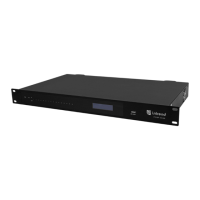Operating Manual for Digital Sound Processor (DSP) V3.0
WWW.INTREND-AV.RU
24
Threshold: When the signal level is higher than the threshold, the compressor/limiter begins to
reduce the gain. Any signal that exceeds the threshold is regarded as overshoot signal, and its level
will be reduced in normal cases. To a greater extent the signal exceeds the threshold, more level is
attenuated.
Ratio: It refers to the compression ratio. The ratio decides the attenuation degree of the overshoot
signal to the threshold level. The smaller the compression ratio is, more easily the signal will be higher
than the threshold. Once the signal exceeds the threshold, the compression ratio decides the ratio of
input signal variation to output signal variation. For example, when the compression ratio is 1:2, if the
input signal is 2dB higher than the threshold, the exceeding part only changes by 1dB. A compression
ratio of 1:1 suggests that the compressor does not attenuate the signal in proportion. The adjustable
range of compression ratio is 1-20.
Starting Time & Release Time: In order to maintain natural oscillation, it is generally hoped that part
of the most original level will pass through the compression without any influence (or just minor
influence). Likewise, if there is a rapid sharp attenuation and rapid recovery in the signal gain, the
suction effect will occur. The starting and release time of the compressor is to avoid such circumstance.
The starting time can decide the speed of gain attenuation, while the release time decides the speed
of gain recovery.
Output Gain: It is also called gain compensation fader. If the compressor significantly reduces the
level of the signal, it may need to enhance the output gain to maintain the volume. Such enhancement
applies to all parts of the signal and is unrelated to other parameter settings of the compressor.
G.R. and output Level Meter: G.R. indicates the compressor's compression amount; output refers to
the output level of the signal that has passed through the compressor module. The compression
amount is displayed in an inverse level meter. If the input signal and threshold are set as -6dB and -
30dB, respectively, and the ratio is 2:1, then the compression amount is 12dB; G.R. level meter
indicates around -12dB and output indicates around -18dB.
Limiter

